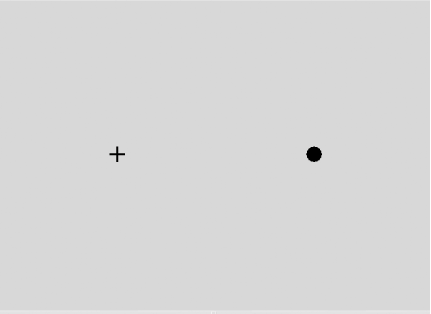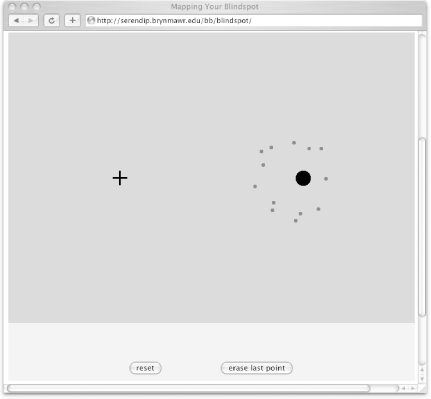Hack16.Map Your Blind Spot
|
Hack 16. Map Your Blind Spot
Find out how big your visual blind spot is and how your brain fills the hole so you don't notice it. Coating the back of each eye are photoreceptors that catch light and convert it to nerve impulses to send to the brain. This surface, the retina, isn't evenly spread with receptorsthey're densest at the center and sparse in peripheral vision [Hack #14] . There's also a patch that is completely devoid of receptors; light that falls here isn't converted into nerve signals at all, leaving a blind spot in your field of viewor actually two blind spots, one for each eye. 2.5.1. In ActionFirst, here's how to notice your blind spot (later we'll draw a map to see how big it is). Close your left eye and look straight at the cross in Figure 2-6. Now hold the book flat about 10 inches from your face and slowly move it towards you. At about 6 inches, the black circle on the right of the cross will disappear, and where it was will just appear grey, the same color as the page around it. Figure 2-6. A typical blind spot pattern You may need to move the book back and forth a little. Try to notice when the black circle reappears as you increase the distance, then move the book closer again to hide the circle totally. It's important you keep your right eye fixed on the cross, as the blind spot is at a fixed position from the center of vision and you need to keep it still to find it. Now that you've found your blind spot, use Jeffrey Oristaglio and Paul Grobstein's Java applet at the web site Serendip (http://serendip.brynmawr.edu/bb/blindspot; Java) to plot its size. The applet shows a cross and circle, so, as before, close your left eye, fix your gaze on the cross, and move your head so that the circle disappears in your blind spot. Then click the Start button (at the bottom of the applet) and move your cursor around within the blind spot. While it's in there, you won't be able to see it, but when you can (only just), click, and a dot will appear. Do this a few times, moving the cursor in different directions starting from the circle each time. Again, be careful not to move your head, and keep focused on the cross. You'll end up with a pattern like Figure 2-7. The area inside the ring of dots is your blind spot. Figure 2-7. Matt's blind spot mapped
2.5.2. How It WorksThe blind spot for each eye corresponds to a patch on the retina that is empty of photoreceptors. With no photoreceptors, there's nothing to detect light and turn it into information for use by the visual system, hence the blind spot. Each receptor cell is connected to the brain via a series of cells that aggregate the signal before reporting it to the brain by an information-carrying fiber called an axon (see [Hack #9]). Bizarrely, the part of the photoreceptor responsible for detecting light is behind the fibers for carrying the information into the brain. That's rightthe light-sensitive part is on the side furthest from the light. Not only does this seem like bad design, but also it means that there has to be a gap in surface of the retina where the fibers gather together to exit the eyeball and run to the brainand that exit point is the blind spot. At first sight, there doesn't appear to be any particular reason for this structure other than accident. It doesn't have to be this way. If the light-detecting parts of the cells were toward the light, you wouldn't need a blind spot; the fibers could exit the eye without interrupting a continuous surface of photoreceptors on the retina. Can we be sure that this is a bug and not a feature? One bit of evidence is that in the octopus eye it was done differently. The eye evolved independently in octopuses, and when it did, the retinal cells have the photoreceptors in front of the nerve fibers, not behind, and hence no blind spot.
We don't normally notice these two great big holes in our field of vision. Not only do our eyes move around so that there's no one bit of visual space we're ignoring, but the blind spots from the two eyes don't overlap, so we can use information from one eye to fill in the missing information from the other. However, even in situations in which the other eye isn't providing useful information and when your blind spot is staying in the same place, the brain has evolved mechanisms to fill in the hole.1 This filling in is why, in the demostration above, you see a continuous grey background rather than a black hole. 2.5.3. Hacking the HackThe Cheshire Cat experiment (http://www.exploratorium.edu/snacks/cheshire_cat.html; full instructions) shows a really good interaction of the blind spot, the filling-in mechanisms and our innate disposition to notice movement competing against our innate disposition to pay attention to faces. With a blank wall, a mirror, and a friend, you can use your blind spot to give yourself the illusion that you can slowly erase your friend's head until just her smile remains. 2.5.4. End Note
2.5.5. See Also
|
|
EAN: N/A
Pages: 159
